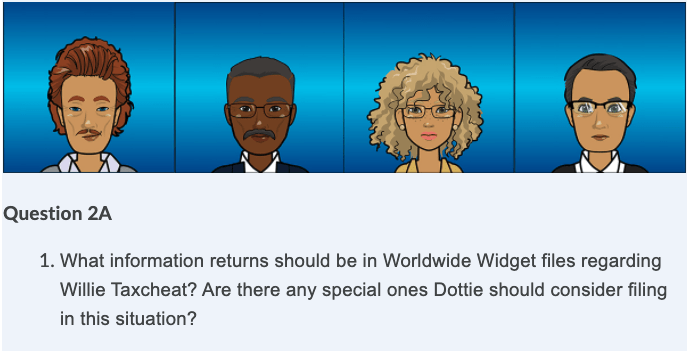Does your course have a story to tell? A fruitful way to view your course is through the lens of narrative or story. No matter what the topic or discipline there is always a way to incorporate storytelling in course design. Embedding your discipline’s concepts into a narrative context has the potential to ignite your students’ curiosity and motivation, because they want to know, “What happens next?”
Whether you use case studies, discussions, scenario-based learning, or problem-solving, threading a narrative through your course is an effective strategy to keep your students engaged. A threaded narrative is a story that extends through each of the modules in your course. It can be framed in a pattern that is sequential, chronological, geographical, spatial, ideological or, simply, a presentation of problems and solutions. By extending the story across modules, you invite your students to immerse themselves in the course material and return to the story to learn.
Worldwide Widgets
In the course Tax Practice and Procedure, we created a narrative about a tax advisor at Beans & Counter and her client at Worldwide Widgets. Students learn the inner workings of the tax system through the characters they meet in the story. We had already mapped the course in a visual way to make sure we could see a connection between our course goals, learning outcomes, assessments and content. We had to do the same thing to extend the narrative across the course.
| Module | Topics Covered | Narrative Plot Summary |
| 1 | Structure of Tax Administration, Tax Law and Ethical issues in Tax Practice |
We will examine the inner workings of our tax system. It is a system run by people. We will meet many types of people throughout this course. In each module students will interact with one or more of these characters. Scenario: A Call from Tax Director Dottie You are a new tax partner in the large accounting Firm Beans & Counter. One of your key clients is Worldwide Widgets, Inc. Your main contact is Tax Director Dottie. |
| 2 | Reporting Obligations, IRS, Investigatory Powers, Civil and Criminal Tax Fraud, Examinations of Returns |
Scenario: Special Agent Sam An unannounced visit from Special Agent Sam. Sam is from the Criminal Investigation Division of the IRS. He is investigating a former employee of Worldwide Widgets. |
A narrative can communicate a wide array of concepts, ideas and theories and add a sense of intrigue and play to your course. Mapping the narrative plot to your topics that were defined by your learning outcomes ensures alignment with the learning outcomes.
There are many different ways to thread a story into your course. Comics can be a fun way to illustrate key concepts relevant to your course. In Tax Practice and Procedure we created comics using Pixton Pro. The sequential order of a comic lends itself to scenario-based learning. Students can interact with authentic scenarios that mirror real-life situations, issues and decision-making. Case studies and discussions can also be adapted into comics or extend from the story within the comic.
The Three E’s of Comics
Josh Elder, the founder of Reading with Pictures sums up the strengths of incorporating Comics in learning with “The Three E’s of Comics” in education:
- Engagement: Comics require readers to actively engage in making meaning from text and images.
- Efficiency: The comic format conveys large amounts of information in a short time.
- Effectiveness: Processing text and images together leads to better recall and transfer of learning
Comic Connection
Comics can make “boring” information more engaging. Factual information and concepts can be presented in context with a setting that incorporates visual representations of people and events. An extended story can provide multiple opportunities for case discussions and ongoing engagement with the concepts being presented. Students can connect to the story personally, apply the concepts they are learning and evaluate scenarios based on their assessment of the situation and update their evaluations as the story unfolds.
Incorporating storytelling into the structure of your course is a valuable tool to encourage students to become more invested in their learning. Students can follow the plot, examine the character’s choices and make recommendations for how a character should proceed. A threaded narrative is an innovative strategy that works across multiple disciplines, and can help your students engage in deeper more holistic learning.




You must be logged in to post a comment.